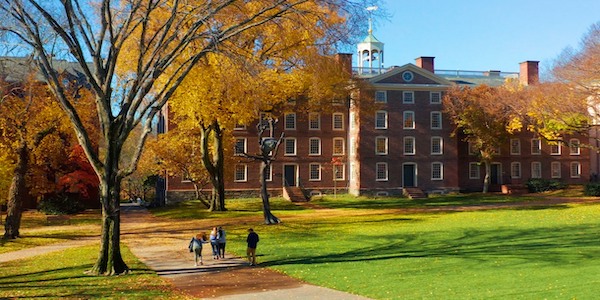Some of the world’s most prestigious institutions for higher learning are on the list of the U.S. list of Ivy League schools. These private institutions are known for their highly selective admissions process, rigorous academic programs, and their habit of graduating future leaders.
Table of contents
That being said, what deems an institution to be “Ivy League” may not be what you think. Though most believe it’s due to a school’s prestigious academics, cutting-edge research, or antiquated heritage, none of those things brought about the term “Ivy League.” In 1954 these schools were more well-known for their success in college sports. The renowned term was coined when these institutions were included at the formation of the NCAA athletic conference for Division I.
Since the 1950s these universities have gained notoriety for accomplishments outside of sports, making them some of the best universities in the world. It’s incredible to think that all but one of these institutions was founded before the Revolutionary War.
While each one holds its own in accomplishments and academics, there is no shortage of rivalry between the Ivy League schools of the United States.
| Rank | School | Location |
|---|---|---|
| 1 | Brown University | Providence, Rhode Island |
| 2 | Columbia University | New York City, New York |
| 3 | Cornell University | Ithaca, New York |
| 4 | Dartmouth College | Hanover, New Hampshire |
| 5 | Harvard University | Cambridge, Massachusetts |
Here is the list of Ivy League Schools in Alphabetical Order!
Brown University

Brown University is a private innovative institution where students embrace an open curriculum. Students design their personalized course of study that allows them to be engaged as open thinkers and intellectual risk-takers. They learn to be multidisciplinary in the rigorous academic pursuit of their education. Those seeking a medical degree can design their program to allow them to complete their entire medical education from undergraduate to postgraduate in eight years.
Brown University is home to six libraries with over 250 special collections that house rare primary research material.
Columbia University
Columbia University boasts one of the most diverse student bodies in the United States and has been an institution on the frontlines for many significant platforms and innovations. Columbia offers a unique focus on research and teaching of global issues while creating cross-cultural and multidisciplinary academic opportunities. The undergraduate schools of Columbia are Columbia College, the Fu Foundation School of Engineering and Applied Science, and the School of General Studies. The graduate schools of Columbia are the business and law schools, the Teacher College, and the Valegos College of Physicians and Surgeons.
Students have access to 22 libraries on campus, 200 research institutes, and laboratories. Students also have access to thousands of internships while they attend Columbia where they build lifetime collaborations with other professionals.
Cornell University
The youngest Ivy League school, Cornell University, was founded in 1865 by Ezra Cornell and Andrew Dickson White. With the mission of instructing any student on any subject of study, Cornell offers an opportunity for students to produce creative work while promoting inquiry across a broad spectrum. The undergraduate colleges of Cornell admit their students and provide their faculty. The largest undergraduate colleges are the College of Arts and Sciences and the College of Agriculture and Life Sciences. Though Cornell is known for all of its graduate schools, perhaps the most well-known is its top-ranked college Cornell SC Johnson College of Business and Weill Cornel Medical College. Other top-ranked graduate colleges are the School of Veterinary Medicine and Hotel Administration.
Dartmouth College
Home to the highly regarded Tuck School of Business, Dartmouth College has been an institution that has lead out in being the first in many ways. Dartmouth opened the first graduate school of management in the world as well as establishing one of the first Native American programs in the country. Dartmouth is also home to the first computer programming language, BASIC, that paved the way for multiple other computing innovations. The learning environment is very intimate and personalized as the faculty to student ratio is 7 to 1, allowing for thorough mentorships and interdisciplinary collaboration. The college offers more than 50 research-focused centers and institutes.
Harvard University
As the oldest institution for higher learning in the United States, Harvard University was founded in 1636. Harvard is perhaps the most recognizable and most selective Ivy League school. Ivy League rankings often list Harvard in one of the top three positions.
As a premier research university, there are over 100 research centers on campus and 13 schools and institutes. Not only are the academics top-ranked but students have options for hundreds of extracurricular, co-curricular, and athletic organizations. Harvard is also home to the oldest library collection and the largest private collection in the world.
Princeton University
Founded in 1746, Princeton University stands out internationally as one of the best research institutions in the world. Princeton is home to numerous specialized libraries and state of the art laboratories and facilities. Students receive a very personalized educational experience with a ration of only 5 students to 1 faculty member. This enables each student to be personally mentored not only by an expert but also a top researcher within their field. A few of the top majors at Princeton are computer and informational support sciences, social sciences, engineering, biological, and biomedical sciences. Princeton has graduated past U.S. presidents, Supreme Court Justices, and Nobel Prize winners.
University of Pennsylvania
As the only Ivy League founded in part by Benjamin Franklin, University of Pennsylvania was founded in 1740. Another distinguishing item that sets U Penn apart from the other Ivy Leagues is that it has the highest international student enrollment with students hailing from more than 100 countries. There is a mix of liberal arts curriculum as well as professional education from students to choose from. The top-ranked schools include the Wharton Schools, the School of Engineering and Applied Science, and the Perelman School of Medicine. The professional graduate schools include the Weitzman School of Design and the School of Dental Medicine. All these programs have engaging state of the art facilities and laboratories in which students learn alongside renowned faculty members.
Yale University
Founded in 1701, Yale University is home to not only the top-ranked law school but the highly regarded Yale School of Drama as well. Other unique programs offered at Yale include the Betty and Whitney MacMillan Center for International and Area Studies where students are educated on international affairs, cultures, and societies around the world. This education comes with opportunities to research abroad. Yale also offers 12 professional schools including schools of law, medicine, management, art, and nursing. Yale was also the first institution in the country to award doctoral degrees to students.
Ivy League schools happen to be ranked among the best institutions for higher learning in the world for various reasons unique to each university. Though most think what determines an Ivy League is its prestige, it actually began as the athletic conference the schools belonged to. Each institution has rigorous admissions and an excellent graduation rate, and each one would be an excellent choice. However, we always recommend researching which school and its programs best fit with your individual education plan before applying.
Ivy League Schools are listed in alphabetical order. Feel free to contact us with any questions.


